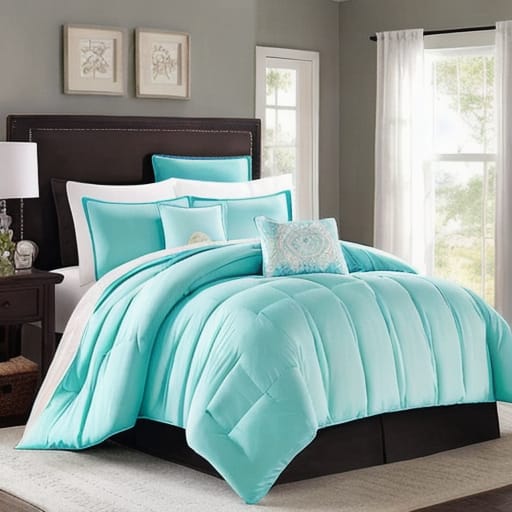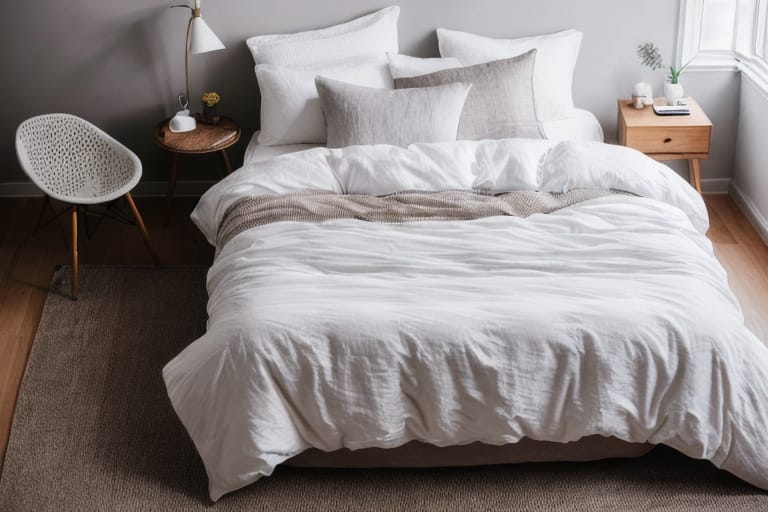Are you looking to add a fluffy, cloud-like down comforter to your bedding collection? Getting a good night’s sleep is crucial, and having the right comforter makes all the difference. This comprehensive guide will teach you everything you need to know when shopping for the ultimate down comforter for luxurious warmth and comfort.
What Are Down Comforters?
A down comforter is a bedding essential filled with insulating down material that traps heat to keep your body warm. Unlike regular blankets which lay flat, down comforters are fluffy, have an even thickness, and drape over your body. The most premium comforters use a fill made from duck or goose down because it provides unbeatable levels of loft, breathability, and durability.
While today’s down comforters use advanced construction techniques, they have been used since the early 20th century to provide exceptional sleeping comfort. The fill power, warmth levels, sizes, and overall quality have vastly improved over time to give consumers better rest than ever before.
Key Factors to Consider When Buying a Down Comforter

Fill Power
The fill power indicates the fluffiness, air pockets, and insulating abilities of the down fill inside the comforter. It ranges from 400 to 900, with higher numbers meaning more loft and warmth for the weight. Consider these fill ratings when buying:
- 400-600: Lightweight; good for warmer climates
- 600-800: All-season regulation; balances warmth and weight
- Over 800: Ultra-warm; ideal for cold regions
Generally, a higher fill down can trap more air and provide better insulation. However, an 800-fill comforter may be uncomfortably heavy for hot environments.
Construction
There are two main construction types used:
- Baffle box: Separate fabric boxes sewn within the comforter prevent fill from shifting. This means more even distribution of insulation.
- Sewn-through: Stitching goes fully through the layers. This causes some cold spots but is still very durable.
Baffle boxes tend to be higher-end with better corner-to-corner warmth. However, sewn-through comforters are usually more affordable.
Fill Material
- Goose down is top-tier, providing exceptional softness and insulation paired with durability. It’s the gold standard for luxury bedding.
- Duck down offers great performance as a lower-priced alternative. Duck clusters are not quite as fluffy.
- Down alternatives like primaLoft synthetic fill or microfiber are hypoallergenic. But they don’t compare to real downs’ cozy feel.
Responsible brands use ethically sourced down from flocks THAT follow animal welfare guidelines. Certifications like the Responsible Down Standard ensure humane practices.
Warmth Ratings
- Lightweight: For people who sleep hot; good for summer or warmer climates (around 300-400 fill power).
- All-season: Provides versatility to adapt to temperatures (around 600 fill power).
- Ultra-warm: Made for cold weather and frigid environments (800+ fill power).
As explained above in the fill power ratings, you can tailor both the fill and shell to meet your insulation needs. People who frequently get hot or cold during the night may want options to layer blankets below their comforter.
Shell Materials
This outer layer of fabric holds the fill in place. Materials like sateen cotton or polyester microfiber balance softness, breathability and strength:
- Sateen cotton provides exceptional luxury with a smooth glide over skin.
- Polyester resists moisture well. Plus, it’s easy to care for.
- Percale cotton is lightweight, crisp and understated. It complements minimalist decor.
For optimal airflow, look for shells made using fine, high thread counts around 400-500 that prevent the fill from escaping through the weave. High-end shells may also feature moisture-wicking technology to limit sweating.
| Material | Price | Softness | Breathability | Durability | Special Properties |
|---|---|---|---|---|---|
| Sateen Cotton | $$$ | Exceptional | Very Good | Good | Luxurious sheen |
| Polyester Microfiber | $ | Very good | Excellent | Excellent | Lightweight; moisture-wicking |
| Percale Cotton | $$ | Very good | Very good | Very good | Matte finish; crisp handfeel |
Advanced Design Features to Know
Baffle Box Patterns
The baffle box design plays a key role in comforters’ weight distribution. Different pattern layouts provide tradeoffs:
- Diamond: Adds strength to prevent fill shifting; provides excellent warmth.
- Channel/grid: Allows for maximum height and loft; very breathable. But it is less durable.
- Double diamond: Really minimizes cold spots or gaps in insulation. It strikes the best balance.
If warmth is your top priority, double diamond baffle boxes are the gold standard. Side sleepers tend to benefit from this even heat circulation.
Corner Loops
Another marker of quality is corner loops rather than just stitched seams. Loops allow you to attach a duvet cover. Plus, they prevent fill from shifting to the corners and compacting there unevenly. Strong ties keep your comforter in place all night.
Antimicrobial Treatments
Advanced brands add antimicrobial finishes both naturally with eucalyptus fibers or using silver ion technology. This protects the materials from developing mildew, mold or bacteria over time. While not a necessity, it’s an excellent bonus feature that extends the usable life of your comforter.
Understanding Down Comforter Certifications

Several certifications indicate responsible manufacturing and materials safety:
- RDS: Responsible Down Standard for animal welfare
- Downmark: Verifies fill power and content accuracy
- OEKO-TEX: Confirms protection from harmful substances
- USDA Organic: Validates sustainable production methods were used
Certification logos on packaging verify that brands met stringent standards. This gives customers peace of mind about health, ethical sourcing, and truth in advertising. High-quality brands invest in trust and transparency.
Caring for a Down Comforter
Follow these tips to keep your comforter clean, fluffy and durable year after year:
- Air out the comforter 2-3 times per year.
- Use a duvet cover to protect the shell.
- Wash on a gentle cycle using mild detergent; air dry.
- Store folded or on its side during off-seasons.
- Fluff gently and massage fill to prevent clumps.
- Steam or dry clean for stubborn soiling issues.
With proper care, a quality down comforter can last over 10 years!
Choosing the Best Down Comforter by Sleep Needs
Here are top-rated options across budgets tailored to different sleeping styles:
| Best For | Product | Price | Key Features |
|---|---|---|---|
| Hot Sleepers | Buffy Cloud Comforter | $170 | 300 thread count shell; lightweight eucalyptus fill good for summer |
| Cold Sleepers | Brooklinen Down Comforter | $249 | Ultra-warm 700 fill power; baffle box design prevents shifting |
| Allergies | LEESURE Baffle Box Down Alternative Comforter | $47 | Affordable hypoallergenic microfiber fill |
| Luxury Style | Snowe Down Duvet Insert | $349 | 700 fill power; sewn corded edges for durability |
From cooling lightweight options to ultra-plush goose down, there are excellent comforters available at many price points. And companies offer 100-night trials to ensure you achieve restful sleep.
Transform Your Sleep with a Down-Right Comforter Tonight
Now that you know how to select the ideal down comforter, you can start experiencing blissfully comfy nights! Pay special attention to the fill power, materials and construction when deciding which model suits your bedroom best. Certifications guarantee ethical standards and safety for your health.
With the proper care, your cozy down comforter will provide many years of phenomenal temperature regulation, breathability and cushioning. Rest easy knowing you’re enveloped in a fluffy hug all night long. Sweet dreams!
Frequently Asked Questions
What is the benefit of a baffle box design in a down comforter?
A baffle box design features separate fabric compartments that hold the insulation in place and prevent it from shifting around. This leads to better warmth distribution so there are no cold spots. Baffle boxes also allow for maximum loft and fluffiness.
How often should you replace your down comforter?
With proper care like using a duvet cover and washing gently in a large commercial machine, a quality down comforter will last over a decade. The fill power and durability does start to break down a bit over time. But you can easily get 10-15 years or more out of a good goose down comforter.
What is the warmest type of down comforter fill?
Goose down offers the most insulating capabilities and warmth for the weight. This is why ultra-warm comforters designed for frigid climates typically have a fill power over 800, using large fluffy goose down clusters. The highest quality goose down provides unbeatable insulation, softness and durability compared to other fills.
Should you store a down comforter in a bag during the summer?
It’s best not to compress and store down comforters tightly in vacuum bags or under heavy items in the off seasons. The compression can damage the delicate clusters over time. Instead, gently fold the comforter and store it loosely on a shelf, maintaining the loft.
How often should you fluff a down comforter?
Fluff and massage the down comforter 2-3 times per month year round. Gently knead any visible clumps or flat spots so the fill distributes evenly again. Regular maintenance prevents uneven temperature regulation or cold spots from developing over years of use.
What is the benefit of ethical down certifications?
Responsible brands source their down feathers from flocks with verifiably humane practices confirmed by audits. Certifications like the Responsible Down Standard ensure the welfare of geese and ducks meets strict guidelines. Conscientious consumers can support ethical down production through their purchases.








